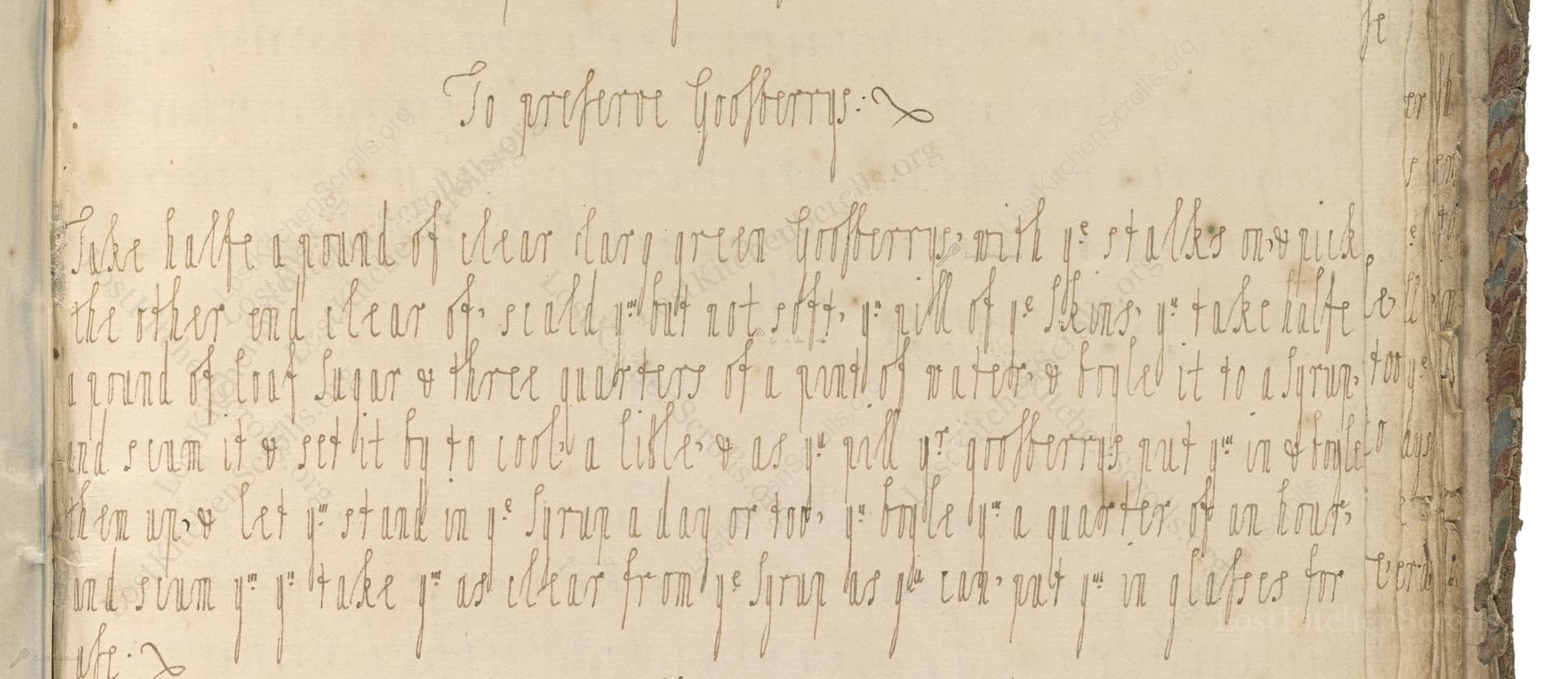To Preserve Gooseberrys
From the treasured pages of Cookbook of Mary Puleston
Written by Mary Puleston

To Preserve Gooseberrys
"Take halfe a pound of clear large green Gooseberrys with ye stalkes on, & prick the other end clear of, scald ym but not soft, & pill of ye skins, & take halfe a pound of loaf Sugar & three quarters of a pint of water & boyle it to a Syrup, then scum it & set it by to cool a litle, & as ye pill ye gooseberrys put ym in & boyle them up, & let ym stand in ye syrup a day or too, & boyle by a quarter of an hour, and scum ym & take ym as clear from ye syrup as ye can. put ym in glasses for your use."
Note on the Original Text
This recipe is written in the conversational, instructive style common to early modern manuscripts. Quantities are given in weights and measures familiar to the time (halfe a pound, three quarters of a pint), with specific steps like 'scald' (blanch) and 'pill of ye skins' (peel off the skins). Unusual spellings ('ym' for 'them', 'boyle', 'ye' for 'the') reflect the period's lack of standardized English spelling, and the use of abbreviations. Steps are sequential but not always strictly timed; the cook is trusted to rely on judgment and observation.

Title
Cookbook of Mary Puleston (1764)
You can also click the book image above to peruse the original tome
Writer
Mary Puleston
Era
1764
Publisher
Unknown
Background
A tantalizing compilation of 18th-century culinary wisdom, this collection artfully preserves the flavors, techniques, and charms of British cookery before 1764—inviting modern gourmets to savor a taste of history with every recipe.
Kindly made available by
Folger Shakespeare Library
This recipe comes from an 18th-century English manuscript, compiled before 1764 by Mary Puleston. Preserving fruit in sugar syrup was a method widely practiced by those with access to domestic fruit gardens and refined sugar, signifying both household self-sufficiency and affluence. Such recipes allowed for fruits to be enjoyed beyond their fleeting season, a delight in genteel homes. Gooseberries, common in British gardens, were celebrated for their tart flavor and firm texture—ideal for preserving in this way, either for winter enjoyment or as a stylish treat at the tea table.

Cooks in the 18th century would have used a large brass or copper preserving pan for boiling syrup and fruit, and a strainer or slotted spoon for careful handling of delicate berries. A small, sharp knife or a sewing needle would have been used to prick the fruits. For storage, glass jars or small covered glasses ('glasses for your use') were standard, sometimes sealed with parchment and tied string to keep them airtight.
Prep Time
30 mins
Cook Time
30 mins
Servings
4
We've done our best to adapt this historical recipe for modern kitchens, but some details may still need refinement. We warmly welcome feedback from fellow cooks and culinary historians — your insights support the entire community!
Ingredients
- 8 ounces large, firm green gooseberries (stem attached)
- 8 ounces white sugar (modern substitute for loaf sugar)
- 1.5 cups water
Instructions
- Begin with 8 ounces of large, ripe green gooseberries, keeping the stems attached.
- Using a small knife or skewer, carefully prick the blossom end (opposite the stalk) of each berry.
- Blanch the gooseberries briefly in boiling water—just until the skins loosen, but do not let them soften completely.
- Remove from the hot water and peel off the skins gently.
- Meanwhile, dissolve 8 ounces of white granulated sugar in 1.5 cups of water in a saucepan.
- Bring to a boil and simmer until it reaches a syrupy consistency, skimming off any foam.
- Allow the syrup to cool slightly.
- As you peel the gooseberries, place them directly into the warm syrup.
- Return the pan to heat and gently bring to a simmer, cooking the gooseberries in the syrup until just tender but not falling apart.
- Transfer the mixture to a bowl or jar and let the berries steep in the syrup for 1–2 days.
- After this period, bring the berries and syrup to a gentle boil for about 15 minutes, again skimming as necessary.
- Carefully lift the berries from the syrup (a slotted spoon works well) and place them into sterilized glass jars.
- Pour some syrup over top to cover, and seal for storage, ideally refrigerating and using within several weeks for best quality.
Estimated Calories
120 per serving
Cooking Estimates
Preparing the gooseberries and syrup takes about 30 minutes. Cooking the berries in syrup takes another 30 minutes total, plus the berries need to steep for 1–2 days. Each serving contains about 120 calories and the recipe makes 4 servings.
As noted above, we have made our best effort to translate and adapt this historical recipe for modern kitchens, taking into account ingredients nowadays, cooking techniques, measurements, and so on. However, historical recipes often contain assumptions that require interpretation.
We'd love for anyone to help improve these adaptations. Community contributions are highly welcome. If you have suggestions, corrections, or cooking tips based on your experience with this recipe, please share them below.
Join the Discussion
Rate This Recipe
Dietary Preference
Main Ingredients
Culinary Technique

Den Bockfisch In Einer Fleisch Suppen Zu Kochen
This recipe hails from a German manuscript cookbook compiled in 1696, a time whe...

Die Grieß Nudlen Zumachen
This recipe comes from a rather mysterious manuscript cookbook, penned anonymous...

Ein Boudain
This recipe comes from an anonymous German-language manuscript cookbook from 169...

Ein Gesaltzen Citroni
This recipe, dating from 1696, comes from an extensive anonymous German cookbook...
Browse our complete collection of time-honored recipes



